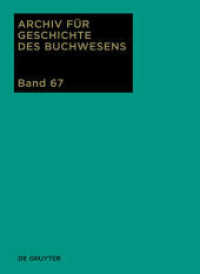- ホーム
- > 洋書
- > 英文書
- > Computer / General
Full Description
This book, LNCS 16193, constitutes the proceedings of the First International Workshop on Digital Twin for Healthcare, DT4H 2025, held in conjunction with MICCAI 2025, in Daejeon, South Korea, during September 23, 2025.
The 15 full papers included in the book were carefully reviewed and selected from 24 submissions. They deal with integrating Digital Twin frameworks with conventional medical imaging and computational tools, focusing on topics such as organ- and disease-specific DT modeling; multi-modal data integration; AI-driven simulation and prediction; DT-guided diagnostic and treatment planning; etc.
Contents
Personalized 3D Myocardial Infarct Geometry Reconstruction from Cine MRI with Explicit Cardiac Motion Modeling.- Microvascular Retinal Digital Twins from Non-Invasive Clinical Images.- Validating Digital Twins with Tactile-Visual Liver Phantoms for Robot-Assisted Surgical Workflows.- A Real-Time Digital Twin for Type 1 Diabetes using Simulation-Based Inference.- Retrospective Evaluation of a Patient-Specific Liver Digital Twin to Predict Thermal Ablation Outcomes in HCC.- Acoustic Simulation with Deep Learning for Low-intensity Transcranial Focused Ultrasound Digital Twins.- Towards Digital Twin of RF Ablation: Real-Time Prediction of Time-Dependent Thermal Effects Using Transformer.- Finite-Element Electrophysiological Modeling of Human Uterine Smooth Muscle Using a Reduced Tong Model.- TF-TransUNet1D: Time-Frequency Guided Transformer U-Net for Robust ECG De-noising in Digital Twin.- DeformMLP: Effective Deformation Prediction for Breast Cancer Using Graph To-pology-Assisted MLPs.- Rule-based Key-Point Extraction for MR-Guided Biomechanical Digital Twins of the Spine.- Towards Robust Algorithms for Surgical Phase Recognition via Digital Twin Repre-sentation.- Personalized 4D Whole Heart Geometry Reconstruction from Cine MRI for Cardiac Digital Twins.- Secure Medical Digital Twins: A Use-Case Driven Approach.- Explainable Prediction of Recurrence After Prostate Cancer Radiotherapy Using in Silico Digital Twin Model and Machine Learning.








